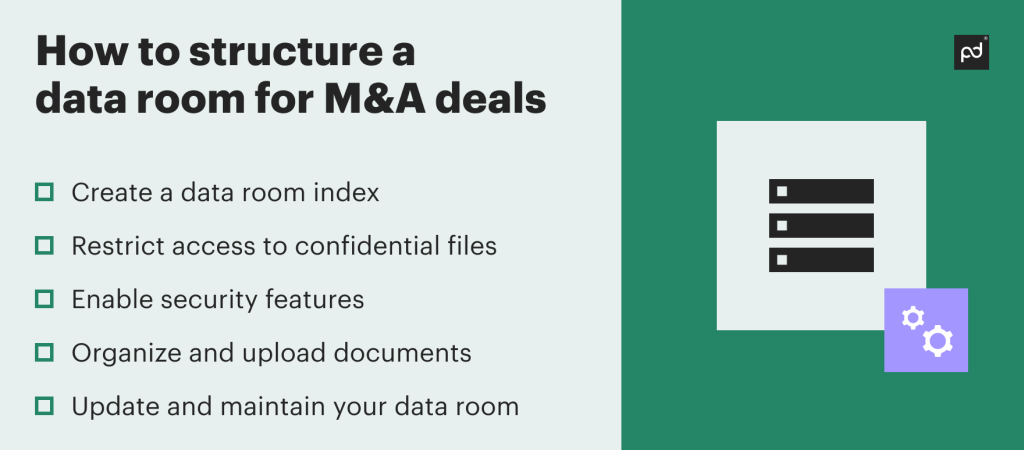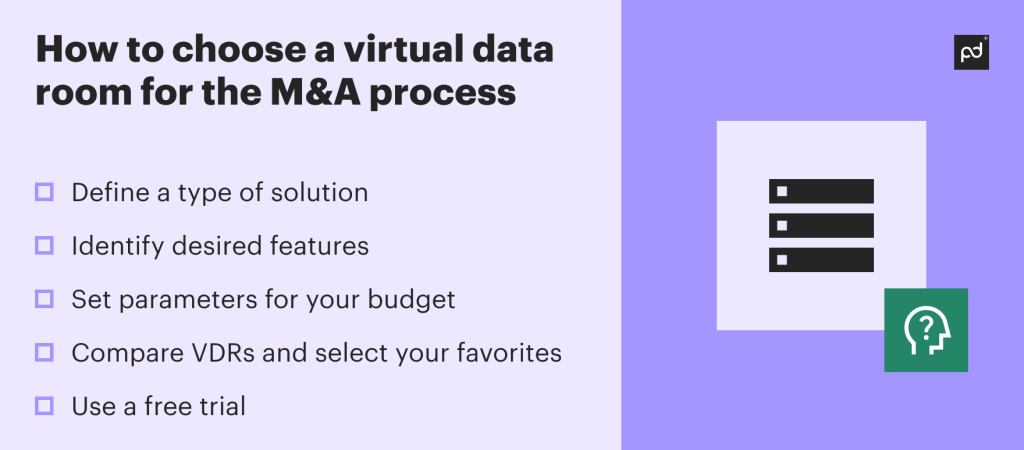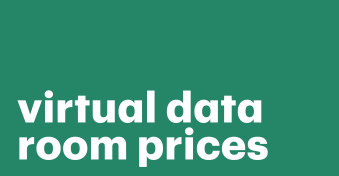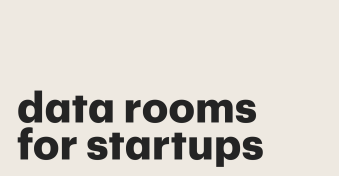Mergers and acquisitions require buyers and sellers alike to enter in a vast amount of confidential company data.
These documents are private and must be kept in a safe place for the duration of the deal, while still allowing appropriate access to all stakeholders involved in the transaction.
A virtual data room (VDR) solves this problem.
It provides a secure, online hub where relevant parties can conduct business virtually.
This article focuses on the benefits of using a virtual data room for mergers and acquisitions, how VDRs are structured for this purpose, and tips on choosing the right one for your M&A deals.
Key takeaways
- A virtual data room (VDR) is a cloud-based repository for storing and sharing confidential documents between parties participating in the mergers & acquisitions process.
- A VDR simplifies the due diligence process, as potential buyers have a centralized, online hub to assess financial, legal, and operational data to uncover risks that could impact the success of the M&A transaction.
- Compared to physical data rooms, VDRs offer advanced security features — two-factor authentication, encryption, access controls, audit trails and more — to protect files from unauthorized access and data breaches.
- In addition to their storage capabilities, virtual data rooms come with functionalities to manage documents, collaborate with stakeholders, and label files, which helps streamline the M&A process.
What is a data room in M&A transactions?
A virtual data room is a secure, online repository to store and share relevant company documentation required for all parties involved in mergers and acquisitions.
The party that’s selling prepares and stores documents related to operations, financials, and legal transactions in a data room, and grants access to potential buyers and their advisors.
In the past, M&A data rooms used to be physical rooms in the seller’s office or on their business premises. Buyers had to make an appointment and physically travel to a location to audit paper documents.
Today, data rooms are virtual, cloud-based solutions that offer secure document sharing and security features at a lower cost compared to physical premises.
All a buyer needs to access a VDR is a stable internet connection and permissions to the room.
When is a virtual data room used during M&A transactions?
A virtual data room is integral to streamlining the due diligence phase of any M&A deal.
This is when a buyer “does their homework” to determine whether to acquire a company — assessing its cost and identifying any risks in the transaction process.
Due diligence is only one phase among the five stages of M&A.
The potential deal is initiated much earlier, starting with the preliminary stage:
- Pre-negotiation: potential buyers meet with sellers in order to understand how they align together in terms of culture, values, and strategic goals. At this stage, potential purchasers enter into a non-disclosure agreement to protect the seller’s sensitive data.
- Assessment: a selling party decides which documents to prepare, scans them (if needed), and uploads them in a virtual data room solution. The seller’s team set up access controls to regulate document viewing and assign permissions to authorized individuals.
- Due diligence: a buyer’s team accesses an online data room to review the target company’s data. They also use collaboration tools like the Q&A section and chats to address questions in a timely manner.
- Closing the deal: a buyer provides funds to the seller, and the seller transfers ownership and full control of the company or assets to the buyer. Both parties sign the purchase agreement, which symbolizes the closure of a deal.
- Post-closure integration/implementation: an online data room serves primarily as a document repository only, when teams from both sides exchange documents for the purpose of integration.
How do virtual data rooms benefit the M&A process?
Here are a few examples of what a VDR can do for you and your team.
1. Provide secure file-sharing
The majority of VDR solutions address security with advanced features such as two-factor authentication, encryption, and audit trails.
Data rooms adhere to major security protocols, including FERPA, GDPR, HIPAA, and eIDAS.
These actions ensure that only authorized individuals have access to sensitive documents and establish a standard for processing and handling confidential information.
2. Cut the time spent preparing and auditing documents
Compared to physical data rooms, VDRs are “open 24 hours” and can be accessed by multiple stakeholders at any time.
Buyers leverage virtual rooms to easily search for topics, words, and phrases within documents instead of conducting a manual search.
As for sellers, they are relieved from the tasks of printing and supervising documents, as is required in a physical room.
3. Increase transparency in the M&A process
VDRs typically include an audit trail feature to track user activities within the platform.
This provides a record of who accessed the data room, when they did so, how often they viewed specific documents and other interactions.
This high level of transparency extends to communication, as all messages, including those in chats, are saved within the system.
4. Reduce associated expenditures
The lessened cost factor is beneficial for both buyers and sellers.
In the case of buyers, a VDR eliminates the need for physical travel, saving money on expenses like hotels and tickets.
For sellers, there’s no need to rent a physical room, hire personnel, or set up security governance to secure data.
How to structure a data room for M&A deals

1. Create a data room index
An index serves as a “table of contents” inside your data room that guides you to the location of files.
Your data room structure should consist of three levels of hierarchy: top-tier folders (e.g., marketing, legal, financial), main folders (e.g., your tax information folder within the top-tier financial folder), and sub-folders.
2. Restrict access to confidential files
Consider who needs access to what folders and documents in your data room, and provide limited access to buyers.
For example, if you have a folder related to financials, ensure that only financial representatives and senior management from the buyer’s side can access it.
3. Enable security features
To ensure secure file sharing, ask your admin to enable watermarking, fence view, encryption, two-factor authentication, and secure login credentials.
Regularly update and audit security protocols, and utilize role-based permissions to maintain a high security standard.
4. Organize and upload documents
Most virtual data room providers enable users to label docs and write metadata such as the date of creation, the author, and background information.
This level of organizing docs ensures that stakeholders can easily find them in the system.
5. Update and maintain your data room
M&A due diligence can often be a long-term process, and documents can become outdated while still under review.
To avoid this, schedule regular reviews of the content to ensure you have accurate information and keep your data room index up-to-date.
How to choose a virtual data room for the M&A process

1. Define a type of solution
Before entering the active search phase, define how much storage you need, the types of documents to be stored, and who is going to use it — a whole company or just a few stakeholders.
These answers will guide you in selecting a suitable solution: it could be a basic cloud storage software like SharePoint or Google Drive, or a specialized VDR software with advanced security and permissions features.
2. Identify desired features
When selecting features for your solution, think of those that benefit the entire deal process. Those can be:
- Document management features with the ability to create and edit documents
- Analytics to provide a view of users’ actions inside files
- Customized permissions to configure whether files can be shared, printed, or downloaded
- Security features with ISO 27001 compliance at its minimum
- Ability to integrate a virtual data room with your BI tools, preferred CRM for reporting, etc.
- Automatic backup of data and ability to recover it in case of a loss
3. Set parameters for your budget
Virtual data rooms generally cost less than physical rooms, but their prices can vary based on factors such as storage size and features.
Setting a ballpark budget to narrow down your search intent can be helpful in the search process.
A professional VDR solution should not have limitations on the number of users, provide a flat-rate pricing structure and include a minimum of 10 GB of storage in the price.
4. Compare VDRs and select your favorites
Compare which data rooms meet your needs using the following questions: Is the solution visually appealing? Does it have a modern interface?
Is it intuitive for team use? Are professional templates available and advanced functionalities available?
5. Use a free trial
Offering a free trial is a common practice in VDR software, so use this opportunity to test ease of use, interface, and functionality.
Final thoughts
Today businesses undergoing mergers and acquisitions choose virtual data rooms more frequently than physical ones to store files and share them with buyers.
It is because they offer better security levels and collaboration features that allow stakeholders to assess files from any part of the world without the risk of data breaches.
Interested in exploring these features?
Leave your business email to start testing PandaDoc’s virtual data room software today!
Disclaimer
PandaDoc is not a law firm, or a substitute for an attorney or law firm. This page is not intended to and does not provide legal advice. Should you have legal questions on the validity of e-signatures or digital signatures and the enforceability thereof, please consult with an attorney or law firm. Use of PandaDoc services are governed by our Terms of Use and Privacy Policy.


